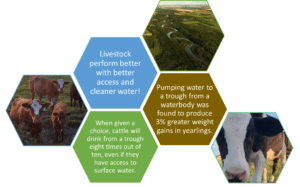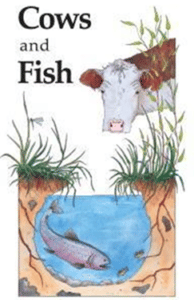Riparian Fencing & Offsite Watering Systems
 What are Riparian Areas?
What are Riparian Areas?
Riparian areas are the transitional areas that exist between the surface water of a river, wetland, or lake and the surrounding drier upland. Healthy riparian areas have abundant vegetation including, trees, shrubs, and herbaceous cover.
What do Riparian areas do?
- Trap & Store Sediment
- Build & Maintain Banks & Shorelines
- Store Water & Energy
- Recharge Aquifers
- Filter & Buffer Water (EMS, SLCN)
- Reduce & Disperse Energy
- Maintain Biodiversity
- Act as animal travel corridors (EMS, SLCN)
- Create Primary Productivity
- Riparian areas act as growing mediums for many traditional medicines that only grow in water or on the shores/banks of lakes and rivers (BLCN)
 (Cows and Fish)
(Cows and Fish)
Threats to Riparian Areas:
Riparian areas have many benefits, including benefits to agriculture. Riparian areas are rich in the diversity of vegetation which acts as shelter and forage to livestock. Livestock can pose an unintentional threat to riparian health and water quality. Impacts from cattle may include:
![]() Increased bare ground & compaction,
Increased bare ground & compaction,
![]() Loss of woody vegetation leading to decreased stream stability and increased erosion potential
Loss of woody vegetation leading to decreased stream stability and increased erosion potential
![]() Decrease in wildlife biodiversity,
Decrease in wildlife biodiversity,
![]() Increase runoff potential (BLCN)
Increase runoff potential (BLCN)
![]() Increase algae growth (manure),
Increase algae growth (manure),
![]() An overall decrease in water quality, and riparian health.
An overall decrease in water quality, and riparian health.
What can be done?
Riparian Fencing and Offsite Watering!
When livestock has unrestricted access to surface water, they can unintentionally contaminate the water supply and decrease the health of riparian areas. Off-site watering and fencing change livestock distribution and reduce their impacts on the land and water. Offsite watering involves piping or pumping water from surface sources to troughs. In trials, cattle were found to walk further to water at a trough than drink from a stream. This may be related to animal security and comfort, where water access from a trough eliminates wading through mud or negotiating a steep streambank and grants the animal the ability to see the surrounding area while drinking.

In 2021, LICA contracted Fiera Biological Consulting Ltd., to conduct Riparian Area Assessments in the Jackfish-Muriel Creeks Watershed, the Upper Beaver Watershed and on Reita Creek. The final reports can be found on the LICA Website, under the Watershed Tab https://lica.ca/watershed/ Or check out presentation recording below!
Other Resources: Cows and Fish are a great resource for riparian areas and grazing management. Check out their ‘Caring for the Green Zone – Riparian Areas and Grazing Management’ booklet or visit their website at https://cowsandfish.org/
Developed in collaboration with Elizabeth Métis Settlement (EMS), Saddle Lake Cree Nation (SLCN), Beaver Lake Cree Nation (BLCN), and Cows and Fish. Funding provided by Alberta Environment and Parks (AEP). 
![]()
